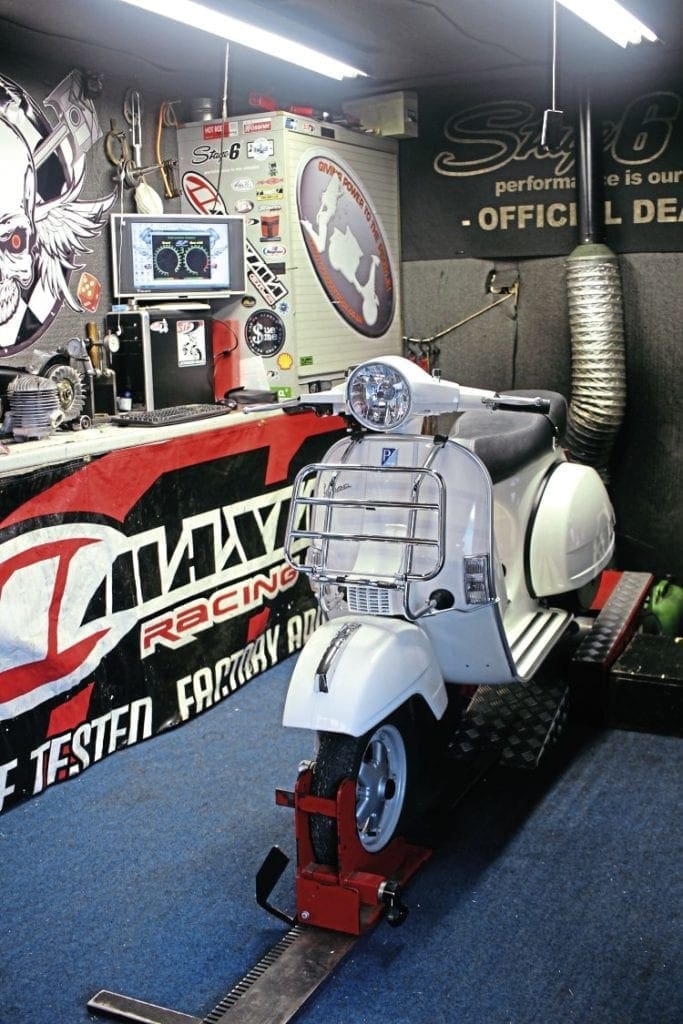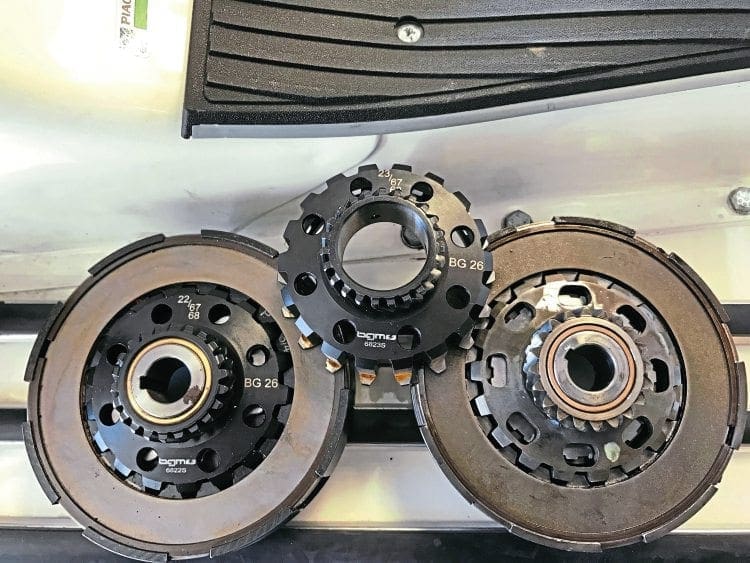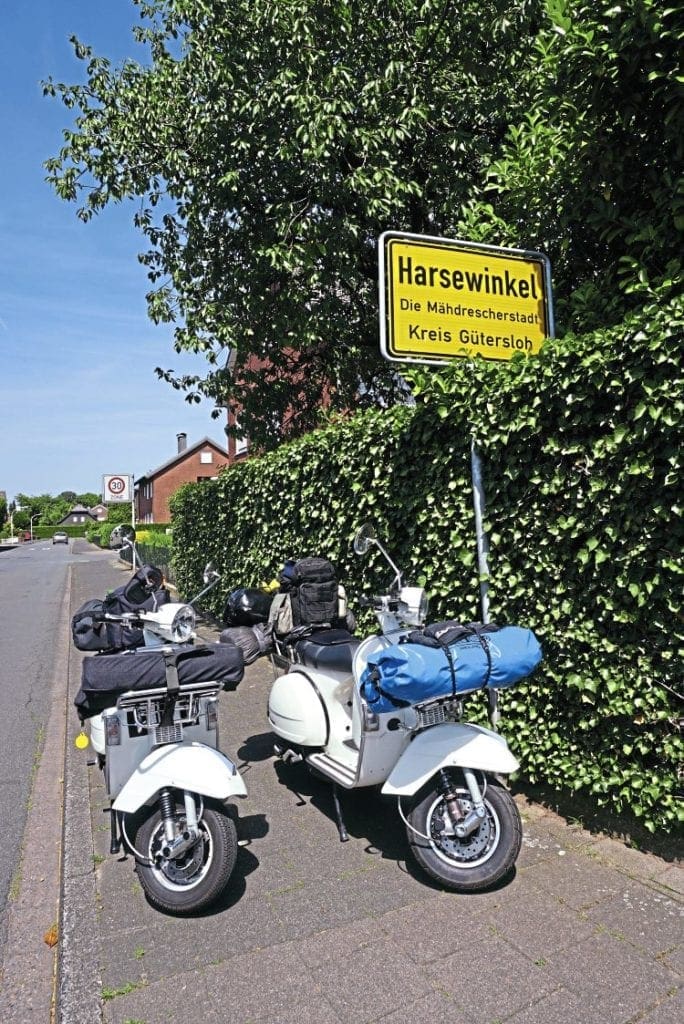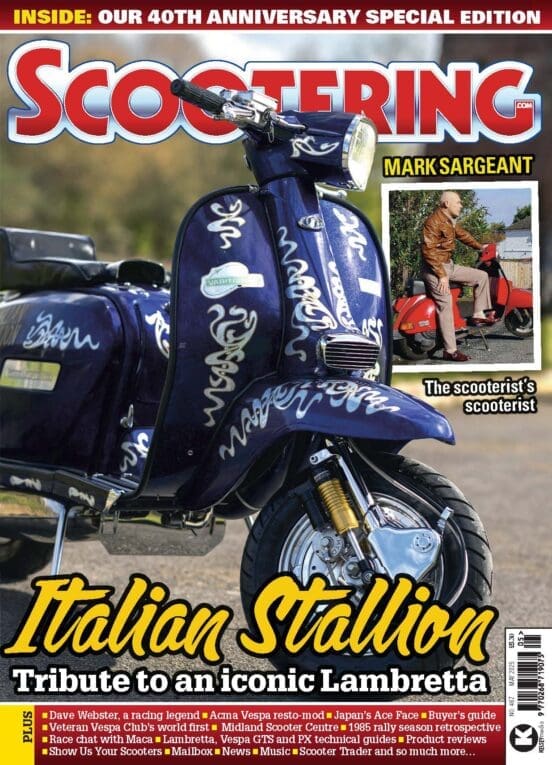Having spent a considerable amount of time bringing the little Vespa PX125 up to scratch, we thought that it would be a good ‘engine proving’ test to send Stan out on a short test ride to Germany. Here’s what he has to say on the matter…
Enter the Stan-man
In the Vespa Tech series Dan transformed a humble PX125 into something far more interesting but what did all this tuning actually mean in the real world? It’s fine seeing ‘wish list’ items fitted, accompanied by dyno graphs and results charts… but how does the bugger ride? That’s what we want to know! So I decided to see if the little PX could be a viable alternative to a P2 for touring. The ride to Vespa World Days in Germany seemed too good an opportunity to miss, particularly as I was travelling there with my friend Simon on his factory specification PX125, so we would be able to make some worthy comparisons.
In standard guise the PX125 produces a rather unimpressive 6.3bhp and eventually reaches a top speed of around 50mph on the flat, taking around 30secs to get there. It’s functional, but by no means exciting… nor does it inspire confidence.
Dan has turned the little machine into a tar more capable scooter. In its current spec the BGM 177 kit on other modifications produces a far more credible 14bhp and Dan has recorded a (GPS) top speed of 67mph with the 22-tooth clutch fitted, which is perfect for his Yorkshire Dales back lane riding. Perhaps a BGM 23-tooth would’ve been more suited to the journey ahead, but with typically little time to spare, other than fitting a rear rack, the only extra preparation for the trip would be fixing a GB sticker to the number plate.
First impressions
I was apprehensive about the ride home from Dan’s workshop as I’m not a fan of tuned engines, if I’m honest. I find their constant demands for rider input tiring over long journeys, but despite my reservations, the 177 actually impressed me from the off. The engine quickly got up to speed with plenty of torque to pull through each gear without having to constantly shift up and down to maintain revs. Planned overtakes were possible whilst staying in fourth gear, but top speed was being held back by short gearing. I repeatedly found myself going for a ‘fifth gear’… Dan was right; the 23-tooth clutch may have been a better cruising choice. I was also pleased to see Pinasco rims from VE fitted, as I wouldn’t nip to the shops on anything other than tubeless. I’ve ridden over 10,000 miles on my own Pinasco splits and beyond replacing the ‘0’ rings, every other tyre change, they’ve been entirely maintenance free. The SIP suspension was also a pleasing upgrade, as my rather substantial combined weight of ‘man and luggage’ would be pushing the chassis to its limits.
An obvious problem though, was going to be the PX’s speedo. Dan warned me that the speedo was around 10% out, but I found that above 50mph it was useless. We have a SIP speedo in waiting for an upcoming tech feature, but that wasn’t in place for this road test. As a result all quoted speeds are from GPS. While talking about performance, I’ll repeat that I’m not the smallest rider. Carrying me at 6ft 2in and 18st, plus full luggage and camping gear, the 177 was effectively running two-up throughout the test.
On the road
On the first day Simon and I stuck close together, which did nothing for the 177. Simon’s 125 was happiest cruising at around 40-45mph, but the 177’s plug kept fouling and I had to keep racing ahead to clear the gap. This style of riding wasn’t my idea of fun and was also eating fuel. In Arnhem we agreed an alternative approach. I’d find the 177’s sweet spot, Simon would cruise at his most comfortable speed and we’d meet up at junctions. The 177’s performance transformed instantly. It would sit cruising happily at a sedate 55mph with more than enough in reserve for overtakes. Unfortunately, over 60mph the engine screamed for another gear. Its fuel consumption settled at around 20% higher than the 125, which is probably in line with a standard P2.
Although Simon’s 125 plodded along at a steady pace, the main difference was on inclines or riding into a headwind. The 125, in Simon’s words “hit a wall” when the restricted CDI kicked in and simply couldn’t power through, while the 177 took things in its stride and motored on in a much stronger fashion.
Stretching a point
Of all the things I was expecting to trouble me, the main problem I actually encountered was with the clutch, or more accurately the clutch cable! There’s no doubt that fitting the uprated item was a wise decision and I found BGM’s clutch very light and smooth in use.
Unfortunately, the factory fitted cable wasn’t up to the task. Over 900 miles it took up to an incredible 25mm of stretch before, inevitably, the cable snapped. I replaced this with an aftermarket inner and things seem to be much improved after that.
My only other issue was with the engine, which was slightly lazy to start first thing in a morning. This is probably down to Dan jetting things slightly rich. Although this is a wise precaution on a tuned engine and caused no problems along the plains of Northern Europe, it could make the thin air of mountain passes more of a challenge. For serious touring the 177 would need leaning out a little compared to Dan’s ‘Yorkshire Dales thrash’ settings.
Final verdict
The easiest way to describe the 177’s performance is that it is very similar to a well set-up P2. Only the exhaust note gives things away and considering the starting point that’s quite an achievement.
For Thursday night rideouts the current set-up is perfect, free revving and quick off the mark. For touring I would fit longer gearing and, to stand a chance of keeping points off my licence, I would replace the speedo.
I set out to find whether the 177 could be a viable tourer and the answer is yes. Good P2s are becoming increasingly expensive, yet there is a seemingly inexhaustible supply of small block PXs. Dan’s experiment proves that there are more options for improving performance than simply transplanting a 200cc engine.
Words & Photographs: Stan













